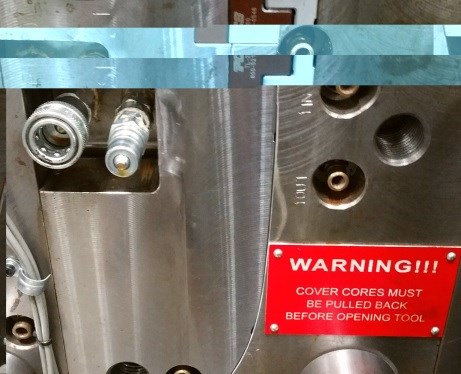Designer's Edge: Hydraulics for Slides, Ejection or Cores
Randy discusses tips and tricks for avoiding mold downtime when it comes to hydraulics for slides, ejection or cores and hot runner plugs or connections.

A male and female connection for set/pull and warning with the sequence.
Randy discusses tips and tricks for avoiding mold downtime when it comes to hydraulics for slides, ejection or cores and hot runner plugs or connections.
When using hydraulics for slides, ejection or cores try to keep them on the sides and bottom of the mold when possible. Hydraulic leak can wreak havoc on the top of a mold as the oil will run down into everything. Connections should be labeled or use different fittings for set and pull. For example, use a male connection and a female connection for the set and pull to prevent improper setup. Also to avoid improper setup, use different sized connections when using multiple hydraulic sequences. This is also important on tools with suicide conditions when the cores and sequence need to be very visible and labeled on the mold to reduce the risk of damage.
Another consideration is the location of hot runner plugs or connections. I prefer to have them on the sides of the mold to prevent issues due to a water leak. If the connectors are on the top of the mold, you run the risk of getting water down inside the hot runner and drops, which can cause downtime and repairs with shorts and/or improper temperature readings.
Also, a hot runner schematic should be on the operator side of the mold that labels the zones and location on the mold to assist with processing and trouble shooting. Note, if using NORYL GFN3 (a standard 30-percent glass-filled material), it will solidify preventing purging if it is allowed to sit and bake for an extended period of time in the hot runner. This results in extended downtime as the hot runner will need to be sent out for cleaning. A good rule of thumb is not to let any material sit and bake for an extended period of time.
When it comes to troubleshooting hot runners in the press, I prefer sprue style hot drop tips whenever possible. They are more maintenance-friendly, have less issues with color changes and allow more options in the press, if you need to adjust the hot drop tip orifices.
On the 15th I will dive deeper into cleaning and maintenance in the press.
.
Related Content
-
The Secrets to Hard Milling Success
The Secrets to Hard Milling Success
-
It Starts With the Part: A Plastic Part Checklist Ensures Good Mold Design
All successful mold build projects start with examining the part to be molded to ensure it is moldable and will meet the customers' production objectives.
-
Fundamentals of Designing the Optimal Cooling System
The right mold components can help improve mold cooling and thereby produce higher-quality parts.














